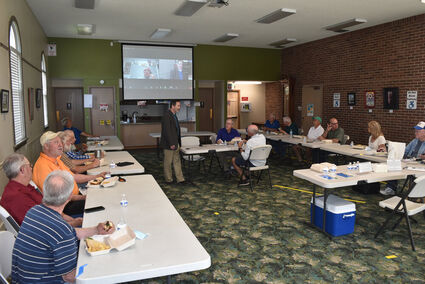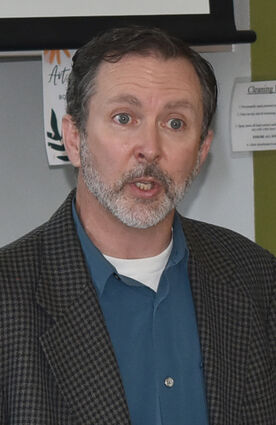WWCC president addresses first Kiwanis in-person meeting
May 20, 2021

-Chronicle photo
The Dayton Kiwanis Club held its first combination in-person/virtual meeting May 13, hosting Walla Walla Community College President Chad Hickox, standing. The club heard a roundup of topics that are challenging the community college. Dr. Hickox asserts that WWCC's future is bright and encouraged community members to engage with the college which is there to serve the educational needs of the region, from Clarkston to Walla Walla and surrounding areas.
By Loyal Baker
DAYTON–For the first time since the coronavirus pandemic brought life to a screeching halt in March, 2020, the Dayton Kiwanis Club held an in-person meeting, and included the members and guests to join via Zoom, ushering in what may become a "new normal" for public entities and civic organizations: the hybrid live and remotely attended meeting.
Chad Hickox, Ph.D., president of Walla Walla Community College spoke to the sixteen Kiwanians and guests that the college's future is bright, even in light of the challenges from changes in the U.S. economy, the pandemic and other socio-economic factors.
COVID-19 resulted in implementation of technology and training for professors to enable both in-person and remote instruction, depending on the student's requirements. "We're entering a phase where everything that we once knew is changed, to some extent," he said.
WWCC staff and faculty will return in July to prepare for full, in-person programs Fall Quarter, Dr. Hickox said. Covid relief funds and a sizeable gift from a philanthropist, plus expectation-exceeding local giving, has been used to support students engaged in instruction at WWCC.
Hickox assumed the office of president about a year ago in the midst of the pandemic shutdown and with recent events rocking WWCC's foundation: Budget cuts, declining enrollment, and workforce layoffs to faculty and staff.
The pandemic hasn't changed some of those trends and themes, but Hickox wanted to point the spotlight on "not where we've come from, per se, but where we are currently and where we are going for the future. We're organizing the college to prepare us to be successful in the future," he said.
To Hickox, the future is bright. With the pandemic in full effect in the fall of 2020, college administration found many students essentially saying "I'll catch you on the flip side," Hickox said. Enrollment dropped "fairly significantly."
But, WWCC has stayed open, save April and May of 2020, when the initial state and national lockdown occurred. "We've been open for workforce programs since May of last year," Hickox said. With vaccinations and relaxation of mask mandates, WWCC is seeing more students coming to campus. "We're moving toward all of our employees coming back," he said, "in the fall quarter. We want them back on campus working July 1. We're going to have as many face-to-face classes as we can and we do still have distancing requirements and other constraints that we face, but what we're pledging to our students it that we can get them whatever schedule they're looking for."
Whether the student wants entirely in-person classes, that can be scheduled, as can entirely on-line instruction and a little of both, he said. "We're developing the computer technology infrastructure that we need and have been developing the skill set among our faculty during the last year plus to make that as seamless as possible."
Hickox's administration learned that a segment of students preferred only in-person classes while another segment was able to attend only because the class was taught virtually, underscored by a recent email he received from an ag-business student from Ohio, who implored Hickox to guarantee the continuation of WWCC's nationally acclaimed ag program. "He couldn't do that if he had to move here," Hickox said, "and he couldn't do it if it weren't online.
"There's going to be a fair resemblance to how we used to do things, but there's going to be parts of what we do that either didn't exist previously or are becoming more mature now," he said.
Hickox noted that 27% of WWCC students are Hispanic or Latinx, a significant increase over past statistics.
The Walla Walla community is roughly 30-31% Hispanic, he said, pointing to the college's role of mirroring its community. "We want to have employees and students that reflect the composition of the community in all respects," he said. Doing so enhances federal funding opportunities.
Female students comprise 64% of enrollment, he said, up from its average in the low 50% range. "We've skewed quite a bit more heavily toward the female students during the pandemic," Hickox said.
Workforce programs have struggled because it's difficult to work on engines or learn to weld without in-person instruction. Hickox said the drop in male students wanting to work with their hands may be explained by those opting to wait until in-person classes return rather than watch lectures online and do practical work in the shop.
Sixty-five percent of students are full time, Hickox said, and, conversely, 35% are not full time. "That's one of the things that's unique about community colleges in general and our community college in particular: we've got a lot of working adults," he said.
Median age is only 22.8 years because WWCC has a lot of students enrolling right out of high school. "A large majority of our students are 25 and older with families and jobs, so they come on a part-time basis to improve their employability and improve their job prospects," he noted. "They have a lot of things to juggle, and the pandemic has only exacerbated that."
Turning to resources, Hickox acknowledged the positive impacts of the Dayton-Columbia County Fund, BMAC, and the WWCC Foundation, dedicated to providing scholarship support. The WWCC Foundation has given "record numbers of dollars" to students over the past year and a half," he said, "and have received record numbers of donations as well. There's just so much need."
WWCC is also fortunate that the federal relief money has provided funds that can be given directly to students for tuition. "The feds say 'here's some money. It's not your money. Give it out to the student,'" Hickox said.
For years, students have been able to turn to Foundation help for everyday expenses like glasses, automotive repairs or rent assistance. "We've used the infusion of federal funds to increase the cash available," Hickox said. "We've put about $2 million into the pockets of students so far and because of that, we've been able to keep a lot of students engaged with the college."
Hickox emphasized that WWCC, except for two months of April and May, has never been closed. "We're moving back to a much more in-person as we speak," Hickox said, imploring those listening to carry that message into the community so prospective students don't dismiss the opportunity.
One of the biggest drivers of WWCC's financial challenges has been low enrollment. "This is true not just for WWCC, but it's true around the country," Hickox said. "Our society is aging. In Walla Walla proper, and some extent in Clarkston, people are moving there because they're lovely places to retire and they're not necessarily seeking college. They're not college age; they're not looking to improve their professional preparedness, so the demographics are not favorable for the college if we continue to do things the way we've always done."
"We're getting creating in ways we're trying to improve enrollment," he said.
Hickox pointed to a large percentage of the population in Walla Walla, Columbia, Garfield and Asotin counties that WWCC serves, who have some college but no degree. Some of the federal dollars may serve to "entice" this segment of the population to engage with the college, he pointed out. In Walla Walla County, it is estimated 16,000 people have some college but no degree, a fairly large percentage.
There were 21 scholarship recipients in Columbia County attending WWCC, he said. "We want more high school graduates coming to us."
Hickox praised the Running Start Program, which allows motivated juniors and seniors to enroll in college-level courses, and possibly graduate with a two-year degree along with a high-school diploma.
College In High School is another WWCC program, with a political science course taught at D.H.S. by Kristine Warren, Hickox said.
Another state-sponsored program, Open Doors, allows students to recover grades from failed or poor-grade classes. In 2019-2020, nine Dayton students availed themselves of the program and one graduated. This year, 10 participated, and three appear on track to graduate. "That sets them on a better path to the future and helps the community," Hickox said.
Federal funds are also equipping classrooms with high-quality microphones and other technology to permit both in-person and online instruction as seamlessly as possible.
While the technology may help remote students attend, Hickox acknowledged that WWCC's primary focus is service the local community.
"We don't want to distract from that," he said. "We want to make sure that we're bringing as many students as possible from Dayton, Pomeroy, Touchet, and Starbuck and everywhere."
WWCC Foundation, which exists to support WWCC, has broken its own record the past couple years with fundraising. "We've crested the million-dollar mark each of the last few years," Hickox said. "It's heartwarming to see the community rise to the need of these students."
This year 17 Columbia County students are receiving scholarships, Hickox said, 21 having received emergency grants. "Those are students who probably wouldn't have been able to go to college but for that," he said.
"In my mind, that number is far too low," Hickox said, adding that coming to Dayton to the Kiwanis Club meeting will hopefully pay dividends in increased enrollment in coming years.
The Mackenzie Scott Grant of $15 million was received by the WWCC Foundation and will be used for scholarships, childcare partnerships, expansion of the ag program and investing in new and existing successful programs. Scott is giving away the money she received in the divorce settlement with Jeff Bezos of Amazon.
Scott calls it "trust-based philanthropy" and gives the college the discretion to use the money as it sees fit. The Foundation, with total investments of around $24 million, hopes to invest the Scott money in a way to maximize returns on investment so the corpus is never touched. "Roughly $600,000 a year is going to be available to the college," Hickox said.
How to invest that money is being discussed, and childcare is presently an urgent need, he said. "How many students can't come to college, or can't take a full load, or can't get the classes that they want to schedule because of child-care issues?" he asked.
Another option under consideration is a local "Promise Scholarship," which would allow any graduating senior from a high school in a designated area to have guaranteed tuition. Such a program would probably include a dedicated capital campaign by the Foundation, he noted. The $600,000 would pay for about 240 students, and there are more than that needing to be served, Hickox said.
Otherwise, the Foundation's contributions from the Scott grant will prop up, support and enhance existing successful programs. WWCC was named the number one ag community college in the United States by Innovate.com, Hickox said. "That's in recognition of the BAS [Bachelor in Applied Science] program, in recognition of our irrigation program, of our animal husbandry program, our soil science program, turf management...we've got a really robust portfolio of ag-related programs."
"We're looking at ways that we can enhance that. We want to be a nationally recognized center because that's going to draw people here."
"Our primary purpose is to push people out into the community who can work on the farms locally, have the knowledge and the skills they need to utilize technology, and to get the highest yields at the lowest cost, but we do that if we create a weather pattern around ourselves. We want to be known for being innovative, and that gets us the best faculty, gets us more students, which gets us more motivated, and it's a self-perpetuating cycle of success," Hickox said.
And the WWCC administration is always seeking ways to expand its programs. Always looking for ways to partner with people in the community.
"We are the community's college, and we're responsive to the needs, so, if you're an employer and your employees don't have the skill set that they need, or you having a hard time finding employees; or if you want to be an entrepreneur and start something in a new sector, but you can't find the talent that you need in the local talent pool, we want to hear from you," he said.
The Enology and Viticulture the college started about 20 years ago, going into an environment of already successful wineries and wine makers. Since then, the wine industry has grown along with the program. "We're putting out skilled winemakers into the community so that people can hire them to make wineries more successful," Hickox said.
"We're always looking for those next opportunities," he said. Hickox mentioned former Blue Mountain Station tenant Rusty Figgins, who started XO Alambic and distilled apple brandy and other spirits, noting that Figgins utilized local produce and tailored it to the local sector, supporting local farmers and businesses and having "a local, Walla Walla Community College twist" with added-value products. Everybody benefits from that, he said.
The college's "bread and butter" is support from the community. Hickox solicited the group for any ideas or connections the college could examine and possibly pursue.
The Strategic Planning process was recently completed, with participation from the community, from staff and faculty, and from students. The final version will be posted on the WWCC website.
"We're not going to allow any of the historical challenges that we've had affect our optimism about the future," Hickox said. "We've figured out where we are going for the next 50 years. We rely heavily on all of you for your input and support."
Responding to questions, Hickox said tuition is currently $5,200, not including books and fees. There are about 114 full-time instructors at the Walla Walla, Clarkston, penitentiary and Coyote Ridge campuses.
Asked about the universities offering online degrees, Hickox said WWCC must differentiate itself with its niche programs, such as its ag offerings. Heavily advertised programs had high percentages of people who didn't graduate, had $30,000 in student loans, and were poorly educated, he said.
A question about higher education across the U.S. being in a state of flux, and whether trade schools are in demand was answered with Hickox pointing out that WWCC doesn't offer traditional trades, such as plumbing or electrician, because rural areas don't have the demand of urban settings.
Hickox was asked about national proposals for free college tuition. All the facets of providing free tuition for a community-college education need careful consideration, Hickox said. "You can't just open the door and say 'come on in,'" he said. There must be funding and support mechanisms, and a way to ensure people want to be there, not just going to college because it's free.
"However, it is for community colleges as I understand it from the Biden Administration," Hickox said. "In general, I think people at the college are fully in support of it. We know that student who get some college, even if they don't graduate, their lives are improved, their lifetime earning potential increases, and their whole family and their whole community is raised by even attending college a little bit.
"Free college, some national-scale project like that, would achieve that purpose, if nothing else," Hickox said.
The last question asked about the "tidal wave of social-awareness training, critical race training" and Hickox said the state's community and technical college system is focusing on it, and resources are being devoted to it. WWCC received a grant from the Sherwood Trust to hire a person dedicated to that work, and the Strategic Plan included equity and access issues, and inclusion.








